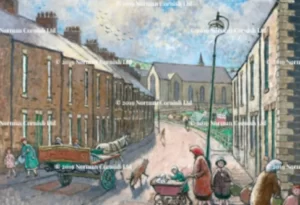Norman Cornish (1919–2014) was an English miner and artist,[1] “one of the most popular northern English artists of his generation”. His style and subject matter have been compared to that of L. S. Lowry, but whereas Lowry was a middle-class outsider looking in at working-class life, Cornish spent more than thirty years as a miner, painting what he experienced around him.[2]
There is a deeper reality to Cornish’s work than just depictions of flat-capped working-class men, as exemplified by his The Crucifixion (1960) a watercolour painted on a page of the Radio Times. It shows a crucified miner on a telegraph pole, expressing his feelings about the treatment of miners: enslaved people spoken to like convicts.[3]
Cornish was born in Spennymoor, a small colliery town in County Durham. At the age of 14, like his father before him, he signed on as a miner at the Dean and Chapter colliery, known locally as “The Butcher’s Shop” owing to the number of accidents that occurred there.[4] In his autobiography A Slice of Life (1989), Cornish recalls that the official welcomed him with the words “You’ve just signed your death warrant son”.[1]
When he turned 15, Cornish joined the Spennymoor Settlement Sketching Club,[5] a breeding ground for creative talent that became known in the press as the Pitman’s Academy.[6] He had his first solo exhibition at the People’s Theatre in Newcastle upon Tyne in 1946.[4]
Cornish continued to work as a miner even after his painting career was established, until his retirement in 1966, when he became a full-time artist.[7]
Personal life
Cornish married Sarah in 1946, and painted many pictures of her occupied by household chores.[1] The couple had two children, John and Ann.[4]










